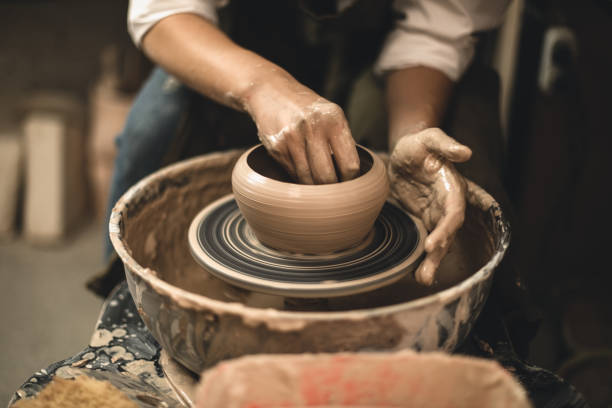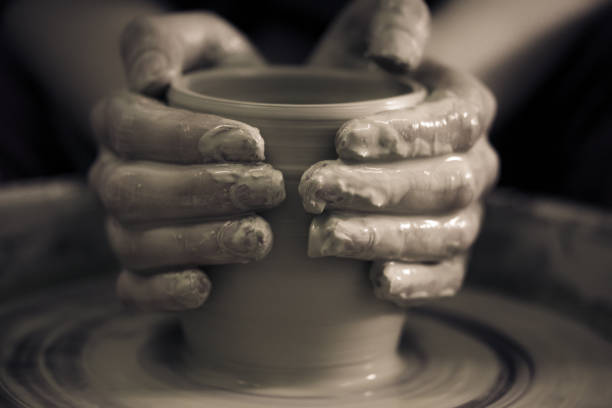Choosing the right pottery wheel can be confusing, especially for beginners. Thankfully, there are a few things to keep in mind when shopping for a new potter’s wheel.
First, consider your space. If you don’t have a lot of room, opt for a smaller wheel like a tabletop model. They’re easier to move around and fit into closets or shelves compared to larger floor-mounted wheels.

Size
If you’re interested in creating symmetrical pottery wares, investing in pottery wheels is the best choice. A standard pottery wheel consists of a flat clay throwing surface and a spinning wheelhead. It’s important to choose the right one for your skill level and needs.
Beginner potters should opt for a pottery wheel with a lever control, which will give you more precise adjustments of the speed and rotation of the wheel head. You also want to make sure that the wheel you select has a power rating that can handle your desired level of ceramic creations.
When choosing a pottery wheel, it’s also important to consider its size and whether or not it will be portable enough for you to move around your studio and home. This is important, as these wheels are typically heavy and difficult to transport. It’s also a good idea to sign up for a pottery class before making the purchase so that you can test out different brands and models of pottery wheels.
Power
The average pottery wheel uses a large amount of power. This is because they are powered by electric motors with a lot of torque or rotational force. Some wheels use a belt system while others are direct drive. A belt drive system looks similar to the way old non-electric sewing machines operated. This means that the potter’s leg continuously swings on a lever, which in turn moves the crank shaft and creates the rotational force needed to work clay.
Some wheels offer a variety of speed settings to allow the potter to make small changes in the rotational speed of the clay, allowing them to shape their clay into more complex forms. This can help keep the piece of pottery looking nice and smooth.
For beginners, Mid-South ceramic supply company usually recommend a quality floor-mounted electric wheel that has a lever control. This will give the beginner potter the best combination of quality and power in a fairly affordable package. Then they can move on to larger, more professional potter’s wheels and kilns. These can be gas, wood or electric depending on what the potter prefers and how big they want to work.

Weight
A typical pottery wheel can weigh quite a bit. It needs to be able to handle the clay being molded, and it also must be strong enough to support itself when in use. It’s important to keep this in mind when shopping around for the perfect pottery wheel for you.
There are several different kinds of pottery wheels, including kick wheels and treadle wheels. Kick wheels, also called momentum wheels, rely on the potter kicking a heavy flywheel in order to build up momentum and throw the clay. These wheels tend to be cheaper, require less maintenance, and can allow the potter to be more connected with their work since they don’t rely on electricity.
A treadle wheel, on the other hand, requires the potter to repeatedly press on a wooden arm at the base of the pottery wheel in order to move the head of the wheel. These wheels are typically more durable and require less maintenance than kick wheels, though they do have a lower clay load capacity. In addition, they’re usually louder than kick wheels and can be difficult to operate for beginners.
Style
A typical pottery wheel has a circular metal disc that sits on top of a shaft that disappears into the body. A plastic pan usually sits beneath and around this disc to catch any water or clay that gets in the way as you’re working. Many modern potters use an electric style of pottery wheel. This allows them to work without having to constantly sweep their foot up and down against the spinning hub. It also makes it easier to maintain a consistent speed.
It’s important to note that the speed at which you work can make or break your pottery. If the clay rotates too quickly, it’ll be difficult to control. This is why most modern pottery wheels include variable speed control functions.
Pottery requires a lot of practice and patience to master. Even the most experienced potters experience creative blocks from time to time. The best thing to do when this happens is take some time to let your mind wander and see if you can come up with an idea to get back on track.
Price
There are a number of factors that influence the price of a pottery wheel. You should always try to buy the best-quality wheels you can afford, as they will last a lifetime if properly cared for.
Pottery wheels can cost anywhere from a few hundred dollars to a few thousand. The type of pottery you plan to create, how often you will use it, and convenience features will all impact your buying decision.
A kick wheel or tabletop pottery wheel that doesn’t require a motor and can be used on a desk top costs a little less than an electric one. They tend to have a smaller centering capacity, however.
Direct-drive pottery wheels typically cost more than other types, but they provide more power, responsiveness, and longevity. They also have the advantage of being quieter than other types of pottery wheels, which can be a huge benefit for potters who work in shared spaces.




